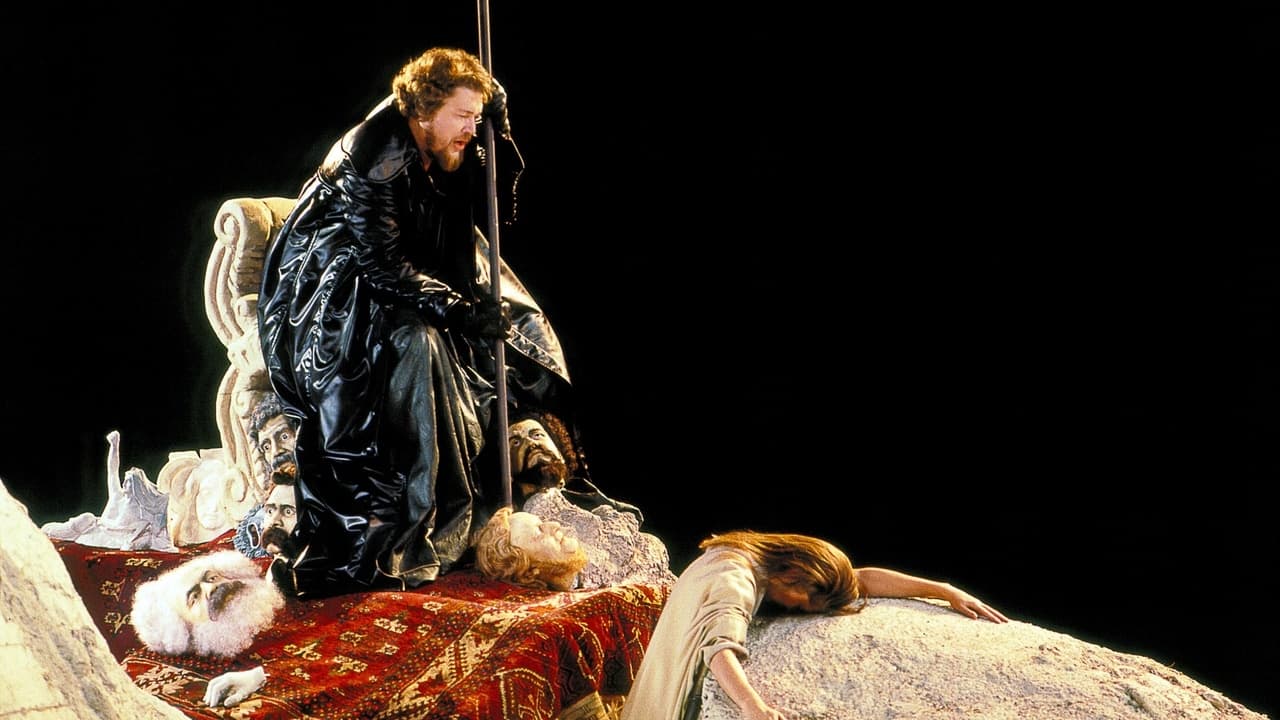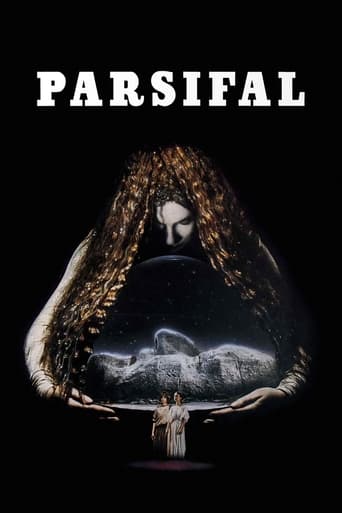ShangLuda
Admirable film.
Pacionsbo
Absolutely Fantastic
Ketrivie
It isn't all that great, actually. Really cheesy and very predicable of how certain scenes are gonna turn play out. However, I guess that's the charm of it all, because I would consider this one of my guilty pleasures.
Lidia Draper
Great example of an old-fashioned, pure-at-heart escapist event movie that doesn't pretend to be anything that it's not and has boat loads of fun being its own ludicrous self.
Tiskit Tothead
This DVD broke my resin-caked heart. Hans Jurgen Syberberg holds a special place in that same sticky heart for directing the longest stoner flick every made, the massive nine-hour Hitler - Ein Film Aus Deutschland. You had to have a kitchen garbage bag chock full of weed to get through all of it, but it is sooo worth it. So I was over the moon when Syberberg had directed a movie of Wagner's Parcifal but not because of the double-dose of self importance one gets from watching both New German Cinema and opera (the more bored you are, the more important you become for sitting through it). No, I was looking forward to puppets and outrageous visuals staged and projected onto those trademark black backgrounds, with a big buttery snow globe to balance it out. Syberberg is obsessed with snow globes and the one in Parcifal is a beaut: a Shining like hedge maze, covered in snow, in the middle of which a giant silver tree with no leaves grows, a fitting symbol for the innocent child-knight's journey to self-discovery through incest. It's great to watch stoned; Rosebud meets kind bud. We also have Wagner's death mask forming the landscape, with the decapitated heads of 19th century German superstars (Marx, Goethe, Nietchze und alles) lined in a row against puppets plunging drills into huge bloody ears . Just makes you're lungs water thinking about it, huh? Well, forget it. The fatal flaw of Parcifal is the singing. Every time someone sings Syberberg parks his camera on them and waits till they finish. And since this is opera, they never finish. He will lay a close-up on you and let his foghorns yap until your t-shirt is covered in drool. Then, in the rare instances no one is singing , the screen takes off into the Syberbergian stuff of dreams. Then someone starts huffing and the whole things crashes to Earth. I don't even think Syberberg was able to get to everything he wanted to in this picture; Hell, there's only one Swastika. How can you have a Syberberg picture, especially one of an opera who's meaning was high-jacked by the Nazis, and have only one Swastika? It's like having a Cheech and Chong picture without some weirded out vehicle for them to drive around in for the whole movie. Even the sex change has nearly no impact. Instead of close-ups, the director would have done better by doing most of the songs as voice-overs, showing the scenes the singers sing about instead of the singer. Or Syberberg could have had his tab of acid and dropped it too, if he had projected film images of the singers over otherworldly scenes of wonder. But no, instead we have a big, sticky kind bud of a dope picture that is riddled with seeds the size of gorilla nuts, nuts called songs. Also, this DVD is merely a transfer of the VHS version that came out in the late Eighties. This means it's full screen and you have to deal with the Nazi -era translation of this opera, something which I'm not sure is done on purpose; it's ironic either way. This film does deserve a wide-screen treatment, though, as well as new subtitles. Mein Deutsche Grammatik Sheisshaus ist, but even twice- baked Tiskit could tell that what they were singing did match what was on screen, especially during the pop-up incest segments. The great visuals over the instrumentals rate a full nine leaves, the best you can get, but the singing parts are little but seeds and stems. So, let's average it out and call it Four Leaves: Worthwhile. Will get a small, pleasant hum from.
Tahhh
This very peculiar setting of Wagner's last opera definitely grew on me. When I first saw it, I was somewhat annoyed by many of the films surrealistic images, and felt that far too much was superimposed upon the story. However, if you can put up with a fair amount of rather recherché "gimmicks," I think you will find that the film DOES manage to capture the very strange, other-worldly atmosphere of the opera, and that there are moments which are particularly fine.Personally, I never really understood the role of Kundry until I saw how Edith Clever portrayed her. Her performance (a lip-synchronized mime of the singing voice of Yvonne Minton) is nothing short of dazzling, from end to end, and alone justifies the hours it takes to absorb the film.Another reason to delight in this film is that it captures the spectacular interpretation of Robert Lloyd of the crucial role of Gurnemanz, one which Lloyd has performed to a crisp at opera houses throughout the world. I have been privileged to enjoy him in the role of Gurnemanz on the stage of the Metropolitan Opera several times, and the lusciousness of his voice, and the warm, fatherliness of his interpretation of this noble character really needed to be preserved, as did his performance in the character's two major monologues, the Karfreitag scene and the recounting of the prophecy in Act 1.The version I have seen was a videotape made for America, and so there were subtitles which, alas, could not be done away with. This is especially unfortunate because the translation used is very inaccurate and forces an extremely Christian interpretation on a film which is already forcing layers of interpretation on the opera. This seemed to me to be quite contrary both to Wagner's clear AVOIDANCE of Christianity, and his very deliberate attempt to "generalize" the Christian elements of the story. (See footnote with spoiler at the end of this review.) I find it nearly impossible, when viewing a film with subtitles, to keep from absorbing them, and strongly recommend that, if in the DVD versions you have the ability to turn the subtitles off, you do so, and instead, if the opera is unfamiliar to you, that you read the libretto carefully beforehand.The bottom line is that there is much in the film which I dislike, and would just as soon have seen done differently...but it has risen steadily in my estimation over the years since I first saw it, and I find myself drawn to enjoy it again and again.__________________________________________________________________FOOTNOTE CONTAINING A SPOILER: A good example would be Kundry's famous line, "I saw him...him...and laughed." This gets translated, in the subtitles, for reasons which escape me, as "I saw the Savior's face." It is especially irritating to me, because throughout the libretto, Wagner very deliberately and carefully refers to this unseen character WHO NEED NOT BE THE BIBLICAL Jesus as "der Heiland," i.e., the German for "The Healer"--a reference to the wound of Amfortas, and to all wounds and maladies and the need for healing.
FloatingOpera7
Parsifal (1982) Starring Michael Kutter, Armin Jordan, Robert Lloyd, Martin Sperr, Edith Clever, Aage Haugland and the voices of Reiner Goldberg, Yvonne Minton, Wolfgang Schone, Director Hans-Jurgen Syberberg.Straight out of the German school of film, the kind that favored tons of symbolism and Ingmar Bergmanesque surrealism, came this 1982 film of Wagner's final masterpiece- Parsifal, written to correspond with Good Friday/Easter and the consecration of the Bayreuth Opera House. This film follows the musical score and plot accurately but the manner in which it was filmed and performed is bold and avant-garde and no other Parsifal takes the crown in its bizarre cinematography. Syberberg is known for controversial films. Prior to this film he had released films about Hitler and Nazism, Richard Wagner and his personal Anti-Semitism and a documentary about Winifred Wagner, one of his grand-daughters. This film is possibly disturbing in many aspects. Parsifal (sung by Reiner Goldberg but acted by Michael Kutter) is a male throughout the first part of the film and then, after the enchantment of Kundry's kiss, is transformed into a female. This gender-bending element displays the feminine/masculine/ying-yang nature of the quest for the Holy Grail, which serves all mankind and redeems it through Christ's blood. In the pagan sorcerer Klingsor's fortress, there are photographs of such notoriously sinister figures as Hitler, Nietzche, Cosima Wagner and Wagner's mistress Matilde Wesendock. The Swaztika flag hangs outside the fortress. Parsifal journeys into the 19th and 20th century throughout the film. The tempting Flower Maidens are in the nude. Kundry is portrayed as a sort of beautiful but corrupt Mary Magdalene or Eve from Genesis (played by Edith Clever but beautifully sung by mezzo-soprano Yvonne Minton). Ultimately, this film is for fans of this type of bizarre Germanic/European symbolic metafiction and for intellectuals who appreciate the symbolism, the history and lovers of Wagner opera. Indeed, the singing is grand and compelling. Reiner Goldberg's Parsifal is a focused and intense voice but it lacks the depth and overall greatness of the greater Parsifals of the stage - James King, Wolfgang Windgassen, Rene Kollo and today's own Placido Domingo. Yvone Minton is a sensual-voiced, dramatic and exciting Kundry, delving into her tormented state perfectly. While the production is certainly unorthodox and as un-Wagnerian as it can possibly get (Wagner's concept was Christian ceremonial pomp with Grails, spears, castles, Knights and wounded kings, a dark sorcerer, darkness turning into light, etc typical Wagnerian themes)..it is still an enjoyable, art-house film.
tostinati
Back when I saw this film when it came out first run at the local art theater, it blew me away. When I tried to get into it again after locating a DVD copy, I couldn't sit through it. Most of the trappings of Syberburg's much-vaunted style have the feel of artsy gimmicks of his hot period, the late 70s and early 80s. The puppets, which are part of this scene, don't bother me half as much as the projection of images over everything on stage, and the shifting video slide show backgrounds. This technique seems to have been a solution that Syberburg believed in deeply-- and to feel he was leading the avant pack in using. But a solution to what, I'm not sure. To break up basically static tableau setups, yes. To speak to the wide-wandering emotional interior state of the films participants, certainly. But why make the film auditorium-bound in the first place if it's restless, ceaseless movement you crave? --Budget limitations? --Because you feel challenged or amused tinkering around with active/static dynamics? Either of these reasons is acceptable to me, but I don't find the fruit of this experimentation especially successful, or more, very durable.The music is great, and I DO yearn for something more eccentric or intense than the standard PBS/Met production with guys standing around bellowing in obvious crepe whiskers and stage dirt. But this film goes arty in a way that doesn't speak to many people any more, and as far as I'm concerned, it way overshoots the crazed artist mark. A little less please.

